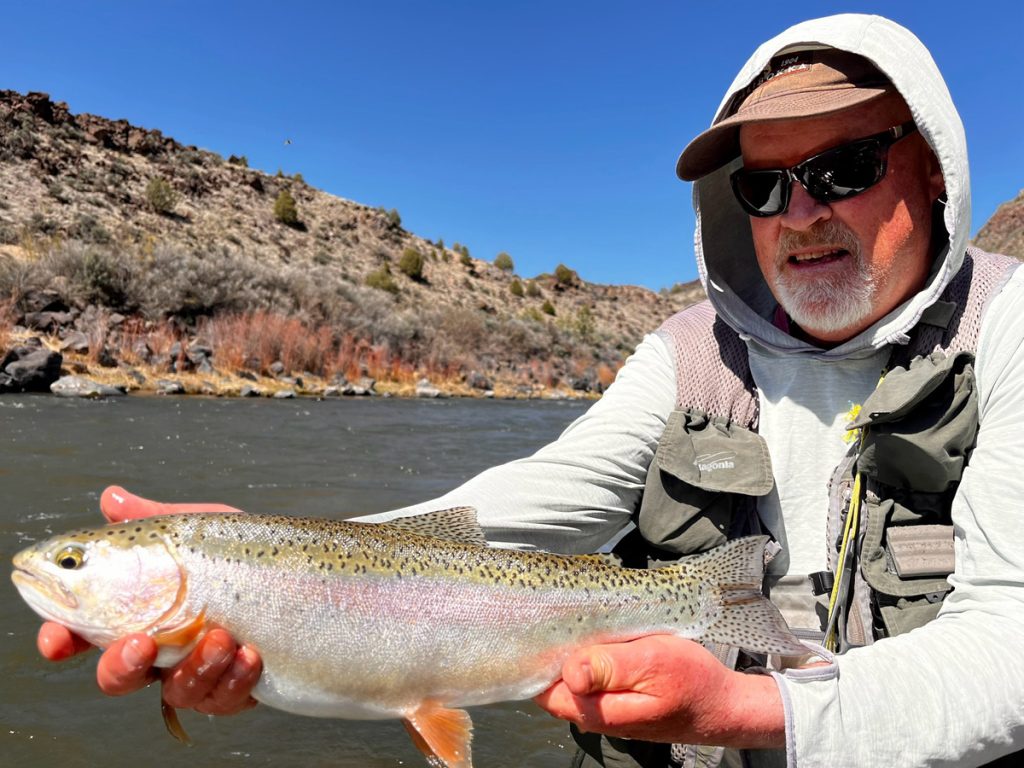
As on many rivers in the western U.S.—the Yellowstone, Sacramento, Arkansas most famously —the caddisfly hatch on the Rio Grande is an event that anglers look forward to every spring. The hatch begins around Velarde in early April, sometimes progressing gradually upstream to the state line, sometimes erupting everywhere at once. Eruption is definitely the word for it. Mothlike caddisflies cloud the air and blanket streamside boulders, which is why it’s not surprising to see the trout celebrating the hatch with us.
During the caddis hatch, abundance and rebirth seem to be everywhere you look. Sap is rising, and buds burst into bloom. Gray gramma takes on a greenish hue as birdsong fills the air. The short sleeves and sunscreen come out, and the river is a flurry of splashing fish.
As experienced caddis nuts are well aware, the chaos isn’t a dawn to dusk affair. Hours can go by with few fish being caught, even as a blizzard of bugs fills the air. This is often because the trout are gorged with flies and pupae and literally can’t eat another bite. The evidence for this is the state of the trouts’ bodies, their bulging bellies and distended sides. Of course, the Rio’s entire fish population doesn’t keep the same eating schedule; fish are always eating, though not always where you happen to be fishing.
When the fishing slows down, drift your flies on or near the stream bottom, nymphs with dark bodies in sizes 12 to 16. A little flash or sparkle helps, though traditional peacock and dark brown hare’s ear bodies will work just fine. When fish start getting busy on the surface, a classic elk hair dry fly is usually all you need. Don’t worry too much about getting the perfect drift, as a dragging dry fly will still draw plenty of strikes. A look at the real flies shows you why: flies are active, flitting here and there across the surface, triggering splashy attacks from fish intent on preventing escape.
The best action usually begins in the middle of the afternoon and lasts until sundown, when my favorite approach is casting a renegade dry fly downstream and letting it swing across the current. I love the hard strikes I get when fishing this method. The biggest challenge is trying not to set the hook but simply raising the rod to tighten into the fish. In most cases, the fish hook themselves, and setting the hook risks breaking the line.
By my observation, lure and bait fishermen catch a small fraction of what fly fishermen do during the caddisfly hatch. Not to say they catch nothing; the water is a perfect temperature in April, and the fish are locked in eating mode. I can definitely imagine that a small Panther Martin, if not reeled in too fast, looks like an emerging caddis pupa and might induce a fish to eat.
Fish are generally insane during this spectacular natural event, a reminder to anglers that we should limit our impact on the fishing resource. Without even trying, we can catch dozens of fish if we’re fishing in the right place and time. After catching enough fish, consider breaking off the point of your hook and swinging your fly just for strikes. You’ll still feel the electricity from the tug on your line. Better yet, you’ll be able to watch the sunset while sharing the river with its happy fish.



